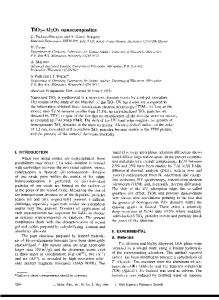Epitaxial growth of V 2 O 3 on Al 2 O 3 by reactive MBE
- PDF / 304,177 Bytes
- 6 Pages / 432 x 648 pts Page_size
- 20 Downloads / 413 Views
Epitaxial growth of V2O3 on Al2O3 by reactive MBE Leander Dillemans1, Tuan Tran 1, Md. Nurul Kabir Bhuiyan1, Tomas Smets1, Mariela Menghini1, Ruben Lieten1, Jin Won Seo2 and Jean-Pierre Locquet1 1 2
Department of Physics and Astronomy, KU Leuven, Leuven, Belgium Department of Metallurgy and Materials Engineering, KU Leuven, Leuven, Belgium.
ABSTRACT Vanadium oxides are strongly correlated electron systems that are interesting both from a fundamental scientific point of view and for possible future applications including memory and sensors. In this contribution, we report on the epitaxial growth of V2O3 thin films on c-Al2O3 (0001) with molecular beam epitaxy and atomic oxygen. We studied the influence of deposition rate and substrate temperature on the structural properties and the metal-insulator transition. INTRODUCTION Vanadates (VxOy) have attracted a lot of attention over the last decades because of their strongly correlated electron character and in particular because of their metal-insulator transitions (MIT). Out of the many stoichiometric V-O phases, the lowest oxidation end-point of the so-called Mangéli phases [1] – namely Vanadium sesquioxide (V2O3) - is of particular interest. V2O3 exhibits a rich phase diagram [2], as shown in figure 1. At ambient pressure, bulk V2O3 undergoes a first order MIT from a paramagnetic metallic (PM) phase with a rhombohedral structure to an antiferromagnetic insulating (AFI) phase with a monoclinic structure, at around 150-160 K. This transition is accompanied by an abrupt change in resistivity of about 7 orders [3] of magnitude. Upon increasing pressure, doping with Ti or excess oxygen, the transition temperature is reduced and eventually vanishes, stabilizing the metallic phase down to 0 K. On the other hand, applying negative pressure, doping with Cr or using oxygen deficiency results in the stabilization of an additional phase. This phase is a paramagnetic insulator (PI) and is isostructural with respect to the PM phase. Because of this latter fact and because of the absence of long-range magnetic order in the PI phase, the PI to PM transition is considered as a genuine Mott transition [4] albeit with a change of lattice parameters. Because of this, V2O3 has served as a model system for ab-initio calculations involving strong electron correlations and for studying the Mott transition and the nature of the correlated metallic phase, see for example ref. [5,6]. Thin films of V2O3 have been synthesized with a number of techniques including PLD [7-9], reactive evaporation [3] and Sol-Gel [10]. Although the bulk phase diagram could possibly be used to interpret results on thin films, the additional parameter of strain can be expected to - in general significantly alter this picture.
61
Figure 1: Phase diagram of bulk V2O3 In this contribution, we use rhombohedral Al2O3 (0001) as a substrate, which has lattice parameters of a= 4.75 Å and c = 12.99 Å [8] in a conventional hexagonal setting. V2O3, having the same space group as Al2O3, has lattice parameters equal to a= 4.9
Data Loading...










